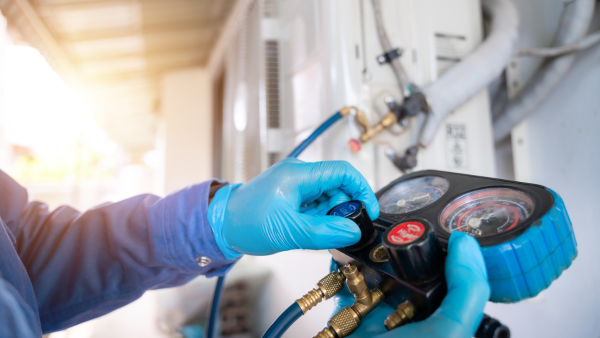Published August 31, 2023
Manage refrigerants to fight climate change, protect your family’s health and save money

by Guest Blogger: MetroParks Sustainability Manager Tim Pritchard
Project Drawdown lists refrigerant management among the most impactful actions for mitigating climate change. This very notion may be confusing to some, as the connection between refrigerants and greenhouse gases is not as commonly discussed as much as vehicle or facility emissions. Additionally, refrigerants are somewhat easy to overlook in daily life. However, they are an integral part of modern living and the way we store food, condition spaces and transfer heat energy.
If devices are properly maintained and carefully managed during installation, lifecycle, and decommissioning, refrigerants do not necessarily pose a direct threat to the atmosphere. However, it is important to remember that refrigerant devices can consume a lot of energy – especially for air conditioning – which is closely associated with emissions.
It is important to keep these devices properly maintained to optimize their energy efficiency and protect them from damage. Doing this avoids the potential for a refrigerant leak. Leakage is the biggest threat these chemicals pose to the environment because they are powerful greenhouse gases, some even causing damage to ozone, which increases the amount of solar radiation collected in the atmosphere.
This is a tricky issue, as most refrigerant evaporate to a colorless, often odorless gas and are not always easy to detect. Gaseous refrigerant can also cause many health issues, from headaches to severe illness.
Fortunately, newer devices use safer refrigerants that have less ozone-depleting potential and are usually less dangerous to human health. Chlorofluorocarbons (CFCs) such as R-22 (Freon), have been phased out and largely replaced with Hydrofluorocarbons (HFCs) such as R-410A.
HFCs do not damage ozone to nearly the same degree, but are extremely potent greenhouse gases. They have an exponential warming effect per volume compared to CO2 emissions. R-410A is now scheduled to be phased out in favor of substances like AL2 which have lower greenhouse gas potential. Fortunately, existing systems can be recharged with different refrigerants than they were installed with, so making the transition does not necessarily mean purchasing new equipment.
Take action as a homeowner or building manager:
- Make sure refrigerant equipment (air conditioning units, refrigerators, freezers, and heat pumps) is installed correctly by a qualified professional and serviced regularly to maintain operating order and ensure any damage is addressed immediately. Routine maintenance will pay off by keeping equipment running efficiently and prolonging its lifecycle.
- Conduct routine cleaning and DIY servicing as recommended by the manufacturer. Make sure heat coils are clean and free of dust and debris, change filters regularly, and check compressors (especially those exposed to the elements) for damage or wear every season. Poor airflow can result in devices not cooling or transferring heat effectively and may manifest as ice buildup on the evaporator or condenser coil.
- Monitor refrigerant lines. These are usually quite protected in a refrigerator or freezer, but AC systems often have long runs between indoor and outdoor components. Check for visible wear or signs of damage. Many modern systems will have a low-refrigerant detection indicator, so it is good to be familiar with it. Low refrigerant can cause severe damage to equipment and even result in entire systems needing to be replaced, so it is valuable to monitor and repair systems as soon as a problem is indicated.
- Retire equipment appropriately. Self-contained refrigerators, freezers, or window/wall AC units can simply be unplugged and transported to recycling. Split AC systems should be disassembled by a professional who can vacuum down and disconnect lines without loss.
- Several metal recycling companies accept refrigerant appliances and will provide a payout for them. It is a legal requirement that the refrigerant lines are intact when delivered so refrigerants can be correctly removed before recycling.
For more information about refrigerants visit the links below:
National Resource Defense Council: The Unexpectedly Exciting World of Refrigerants





